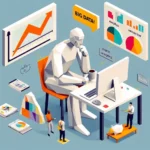When it comes to data analytics, there are a ton of awesome tools and technologies that can help you turn raw data into valuable insights.
From data visualization software that lets you see your data in new and exciting ways, to machine learning algorithms that can predict the future, to big data platforms that can handle massive amounts of information, there’s no shortage of cool stuff to play with.
For example, data visualization software like Tableau and QlikView can help you take a huge pile of data and turn it into beautiful, interactive visualizations that make it easy to spot trends, patterns, and outliers. And if you want to go even further and create complex, animated, 3D visualizations, tools like D3.js and Plotly can help you do that too.
But data visualization is just the tip of the iceberg. If you want to get really fancy, you can use machine learning algorithms to make predictions about the future. For example, you could use a decision tree algorithm to predict whether a customer is likely to churn, or a neural network to predict the stock market. And if you want to process huge amounts of data in real-time, you can use big data platforms like Hadoop and Spark to do it.
So whether you’re just getting started with data analytics, or you’re a seasoned pro looking for some new tricks, there are plenty of tools and technologies out there to help you turn your data into insights, and maybe even have a little fun along the way.
About data visualization.
Data visualization software is a type of software that allows users to create visual representations of data. This can include simple graphs and charts, as well as more complex visualizations such as heat maps, scatter plots, and network diagrams. Data visualization software is often used in data analytics to help users understand and interpret large amounts of data in a more intuitive and meaningful way.
Data visualization software typically includes a range of features and tools that make it easier to create and customize visualizations. This can include features for formatting and styling visualizations, such as changing colors, fonts, and layouts, as well as features for adding labels, annotations, and other visual elements. Many data visualization tools also include pre-built templates and examples that users can customize to quickly create common types of visualizations.
In addition to creating visualizations, data visualization software often includes tools for analyzing and interacting with the data. This can include features for filtering, sorting, and grouping data, as well as tools for performing basic statistical calculations and creating interactive visualizations that allow users to explore and drill down into the data.
Overall, data visualization software is a powerful tool for data analytics, allowing users to create compelling and informative visualizations that make it easier to understand and interpret data. By using data visualization software, users can gain insights and make better decisions based on their data.
About machine learning.
Machine learning algorithms are a set of algorithms that allow a computer to learn from data without being explicitly programmed. These algorithms use mathematical models to make predictions or take actions based on the data they are given. Some common examples of machine learning algorithms include decision trees, support vector machines, and neural networks. Machine learning algorithms can be used in a wide range of applications, such as image recognition, natural language processing, and predictive analytics. The goal of machine learning algorithms is to improve their performance on a specific task over time by learning from the data they are given.
About machine learning algorithms.
Machine learning algorithms are a type of algorithm that allow a computer to improve at a specific task over time by learning from data. These algorithms use mathematical models to make predictions or take actions based on the data they are given. Some common examples of machine learning algorithms include decision trees, support vector machines, and neural networks. Machine learning algorithms can be used in a wide range of applications, such as image recognition, natural language processing, and predictive analytics. The goal of machine learning algorithms is to improve their performance on a specific task over time by learning from the data they are given.
About big data platforms.
Big data platforms are systems designed to store, process, and analyze large volumes of data. These platforms typically have the ability to handle data from a variety of sources, including structured and unstructured data, and can process it in real-time or near-real-time. Some common features of big data platforms include distributed storage, parallel processing, and scalability. These platforms are often used in applications such as fraud detection, recommendation engines, and network security. The goal of big data platforms is to enable organizations to gain insights from their data and make more informed decisions.
What are potential use cases for data analytics?
- A retailer can use data analytics to identify trends in customer behavior, such as the most popular products, the times of day when customers are most likely to make purchases, and the factors that influence customer loyalty. This can help the retailer make better decisions about inventory management, marketing, and customer service.
- A healthcare provider can use data analytics to identify trends in patient health and treatment outcomes, such as the most effective treatments for a particular condition or the factors that influence patient recovery times. This can help the provider make better decisions about resource allocation, treatment plans, and patient care.
- A financial institution can use data analytics to identify trends in customer behavior and financial markets, such as the factors that influence investment decisions or the risks and opportunities associated with different investment products. This can help the institution make better decisions about product development, risk management, and customer service.
- A transportation company can use data analytics to identify trends in vehicle performance, such as the most common causes of mechanical failure or the factors that influence fuel efficiency. This can help the company make better decisions about maintenance, route planning, and vehicle deployment.
Overall, data analytics can be used in a wide variety of contexts to identify trends, patterns, and relationships in data, and to make better decisions based on that information. By leveraging the power of data and analytical techniques, organizations can gain insights that can help them improve operations, drive innovation, and gain a competitive advantage.
























